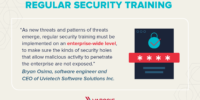In a digital age where cyber threats loom large, fostering cybersecurity awareness is more critical than ever. It’s not just the responsibility of IT professionals; it’s a collective effort that involves everyone in an organization. In this article, we’ll sprint through quick tips to build robust cybersecurity awareness, creating a united front against cyber threats. ️
1. Start with Engaging Training Programs
Begin the cybersecurity awareness sprint with engaging training programs for employees at all levels. Utilize interactive sessions, real-world scenarios, and practical demonstrations to make the training both informative and interesting. Engaged employees are more likely to retain and apply cybersecurity best practices.
2. Communicate Regularly and Clearly
Communication is key to building cybersecurity awareness. Regularly share updates on the latest cyber threats, security policies, and best practices. Use clear and concise language, avoiding technical jargon that may confuse non-technical staff. Open channels for questions and discussions to encourage a culture of curiosity and understanding.
3. Foster a “Think Before You Click” Mindset
One of the simplest yet most effective cybersecurity habits is promoting a “think before you click” mindset. Train employees to scrutinize emails, links, and attachments before interacting with them. This habit can prevent falling victim to phishing attacks, a common entry point for cyber threats. ️
4. Implement Strong Password Practices
Passwords are the frontline defense against unauthorized access. Encourage the use of strong, unique passwords and the implementation of multi-factor authentication. Regularly remind employees to update passwords and avoid using easily guessable combinations. A strong password policy is a fundamental aspect of cybersecurity.
5. Conduct Simulated Phishing Exercises
Put cybersecurity awareness into action by conducting simulated phishing exercises. These exercises mimic real-world phishing attempts, allowing employees to experience and learn from potential threats in a controlled environment. Regular simulations keep security awareness sharp and enhance resilience.
6. Establish a Reporting and Response Framework
Create a reporting and response framework to empower employees to report suspicious activities promptly. Ensure that there’s a clear process for reporting incidents, and establish a rapid response plan. Encourage a culture where reporting is seen as a proactive contribution to overall cybersecurity.
Conclusion
Building cybersecurity awareness is not a marathon; it’s a sprint that requires continuous effort and vigilance. By starting with engaging training programs, communicating regularly and clearly, fostering a “think before you click” mindset, implementing strong password practices, conducting simulated phishing exercises, and establishing a reporting and response framework, organizations can strengthen their cybersecurity posture. Embrace the sprint, stay vigilant, and create a cyber-resilient environment for all. ♂️








